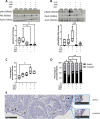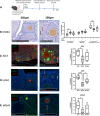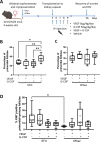BEZ235-Mediated PI3K/mTOR dual inhibition improves ovarian follicle survival in a preclinical model
- PMID: 40537830
- PMCID: PMC12178012
- DOI: 10.1186/s12958-025-01427-7
BEZ235-Mediated PI3K/mTOR dual inhibition improves ovarian follicle survival in a preclinical model
Abstract
Background: Follicular loss after ovarian tissue cryopreservation and autotransplantation (OTCTP) remains a major challenge due to follicle activation and ischemia. We evaluated BEZ235, a dual PI3K/mTOR inhibitor, as a strategy to improve follicle survival in a preclinical model. Its effects were evaluated during ovarian culture, cryopreservation, and transplantation, including the potential benefit of post-grafting VEGF/G-CSF injections.
Methods: Murine ovaries, organotipically cultured with chemotherapeutic treatment (4-HC, 2 µM), with or without supplementation with BEZ235 (1 µM), rapamycin (1 µM), LY294002 (25 µM), or AMH (200 ng/ml) were used to evaluate follicle activation. For cryopreservation studies, those inhibitors were added to the freezing medium, and pathways activation were assessed via Western blot. In vivo, ovaries cryopreserved with or without BEZ235 or rapamycin were autotransplanted under the kidney capsule of mice. A subset of mice received intraperitoneal VEGF/G-CSF injections for five days post-transplantation. Follicle quantification, proliferation and activation marker assessment, and fibrosis evaluation were performed three weeks post-grafting.
Results: In vitro, BEZ235 significantly counteracted chemotherapy-induced activation of both Akt and mTOR pathways, whereas rapamycin and LY29400 inhibited only mTOR or Akt, respectively. Similarly, during cryopreservation, only BEZ235 significantly reduced activation of both pathways. AMH did not enhance BEZ235's protective effects. In vivo, ovaries slow-frozen with BEZ235 retained a higher percentage of primordial follicles and showed reduced follicle proliferation and activation compared to both control and rapamycin three weeks after transplantation. Additionally, post-grafting injection of VEGF/G-CSF did not further enhance follicle preservation or reduce fibrosis.
Conclusion: Dual inhibition of PI3K/mTOR with BEZ235 provides superior protection of the primordial follicle pool by maintaining follicle dormancy, in both in vitro and in vivo models. These findings highlight BEZ235's potential to enhance OTCTP outcomes, extend graft longevity and improve fertility preservation strategies in women.
Keywords: BEZ235; Fertility preservation; Follicle activation; Organotypic ovarian culture; Ovarian tissue cryopreservation; Ovarian transplantation; PI3K/PTEN/Akt signaling; Preclinical mouse model; mTOR inhibition.
© 2025. The Author(s).
Conflict of interest statement
Declarations. Ethical approval and consent to participate: This study was approved by the Animal Ethics Committee of the University of Liège (#1934 and #2594). We confirmed that all experiments in this study were performed in accordance with the relevant guidelines and regulations. All the procedure of the study is followed by the ARRIVE guidelines. Consent of publication: Not applicable. Competing interest: The authors declare no competing interests.
Figures





Similar articles
-
A dual-drug strategy to enhance the function of cryopreserved ovaries by promoting revascularization and inhibiting follicle over-activation.Reprod Biol Endocrinol. 2025 Jul 3;23(1):95. doi: 10.1186/s12958-025-01422-y. Reprod Biol Endocrinol. 2025. PMID: 40611136 Free PMC article.
-
The mTOR Inhibitor Rapamycin Counteracts Follicle Activation Induced by Ovarian Cryopreservation in Murine Transplantation Models.Medicina (Kaunas). 2023 Aug 16;59(8):1474. doi: 10.3390/medicina59081474. Medicina (Kaunas). 2023. PMID: 37629764 Free PMC article.
-
Pharmacological inhibition of the PI3K/PTEN/Akt and mTOR signalling pathways limits follicle activation induced by ovarian cryopreservation and in vitro culture.J Ovarian Res. 2021 Jul 19;14(1):95. doi: 10.1186/s13048-021-00846-5. J Ovarian Res. 2021. PMID: 34275490 Free PMC article.
-
Individualised gonadotropin dose selection using markers of ovarian reserve for women undergoing in vitro fertilisation plus intracytoplasmic sperm injection (IVF/ICSI).Cochrane Database Syst Rev. 2018 Feb 1;2(2):CD012693. doi: 10.1002/14651858.CD012693.pub2. Cochrane Database Syst Rev. 2018. Update in: Cochrane Database Syst Rev. 2024 Jan 4;1:CD012693. doi: 10.1002/14651858.CD012693.pub3. PMID: 29388198 Free PMC article. Updated.
-
Recent advances in the field of ovarian tissue cryopreservation and opportunities for research.J Assist Reprod Genet. 2017 Jun;34(6):709-722. doi: 10.1007/s10815-017-0899-1. Epub 2017 Apr 1. J Assist Reprod Genet. 2017. PMID: 28365839 Free PMC article.
References
-
- Grynberg M, Poulain M, Sebag-Peyrelevade S, le Parco S, Fanchin R, Frydman N. Ovarian tissue and follicle transplantation as an option for fertility preservation. Fertil Steril. 2012;97(6):1260–8. - PubMed
-
- Donnez J, Dolmans MM, Pellicer A, Diaz-Garcia C, Sanchez Serrano M, Schmidt KT, et al. Restoration of ovarian activity and pregnancy after transplantation of cryopreserved ovarian tissue: a review of 60 cases of reimplantation. Fertil Steril. 2013;99(6):1503–13. - PubMed
-
- Levine JM, Kelvin JF, Quinn GP, Gracia CR. Infertility in reproductive-age female cancer survivors. Cancer. 2015;121(10):1532–9. - PubMed
-
- Friedman O, Orvieto R, Fisch B, Felz C, Freud E, Ben-Haroush A, et al. Possible improvements in human ovarian grafting by various host and graft treatments. Hum Reprod. 2012;27(2):474–82. - PubMed
MeSH terms
Substances
Grants and funding
LinkOut - more resources
Full Text Sources
Research Materials
Miscellaneous

